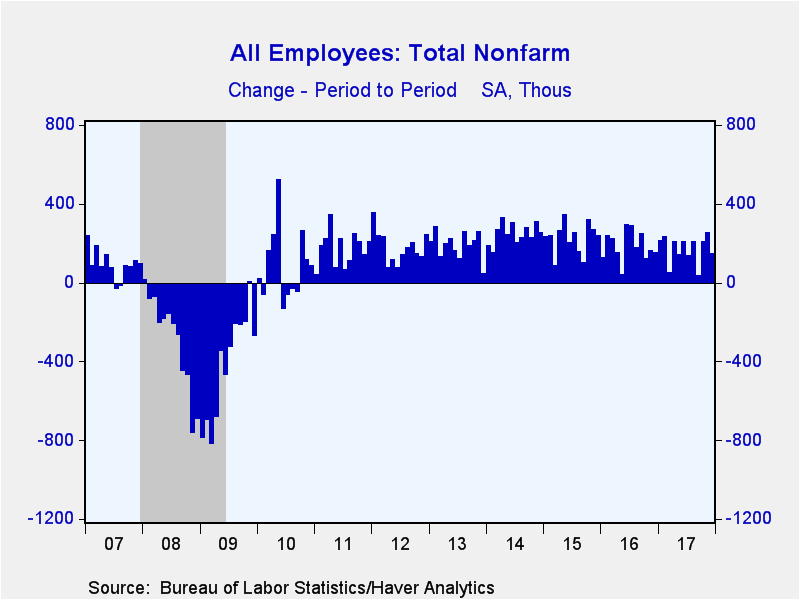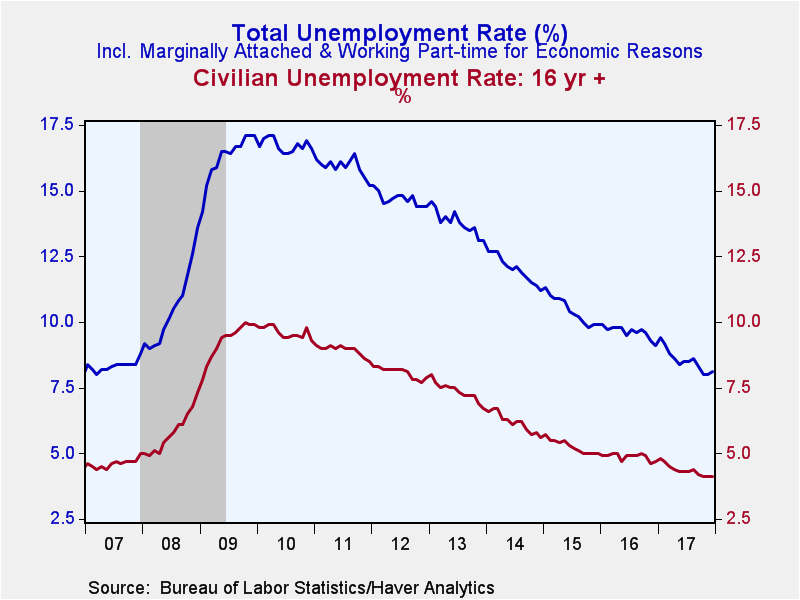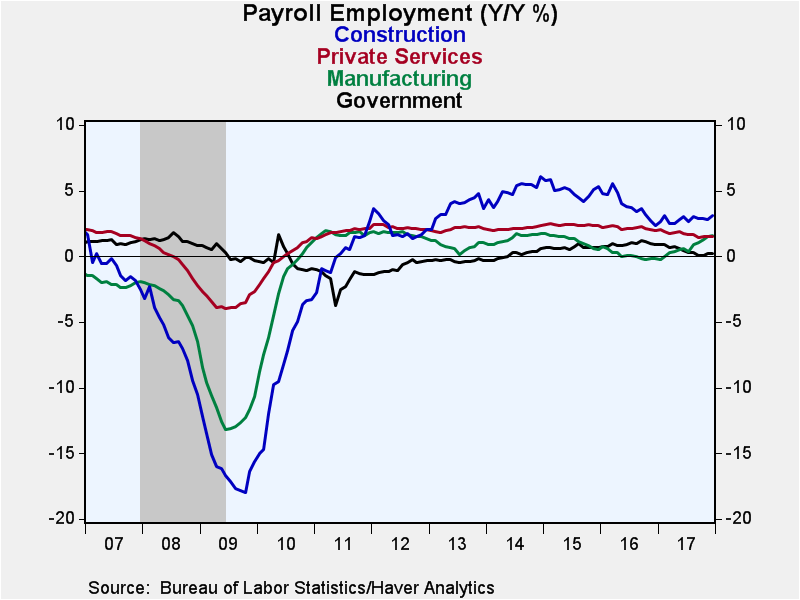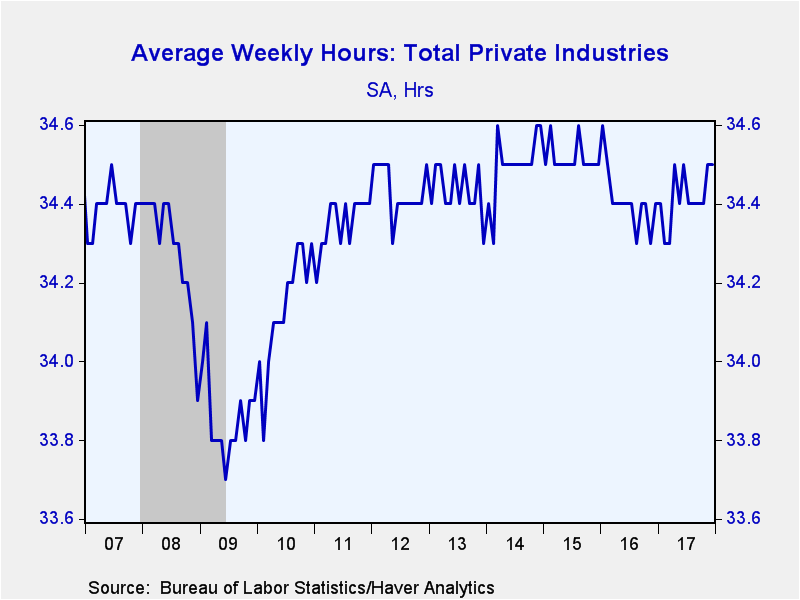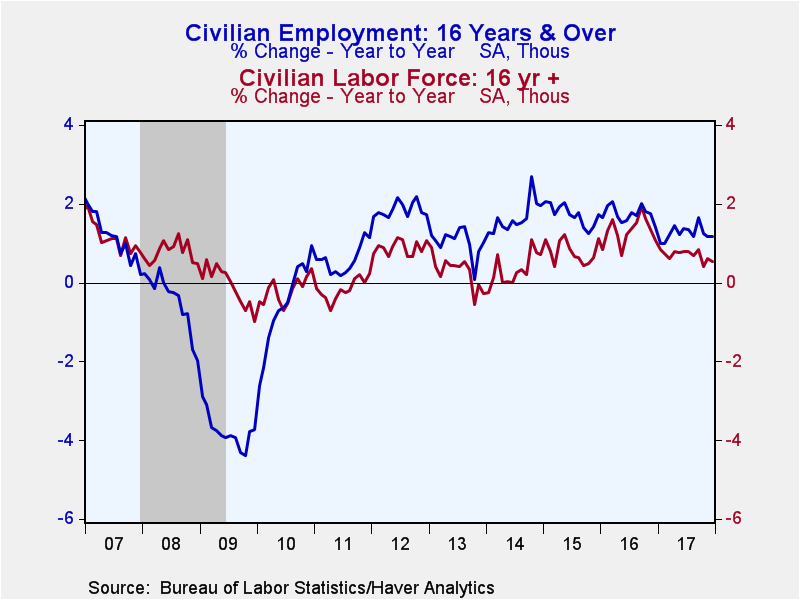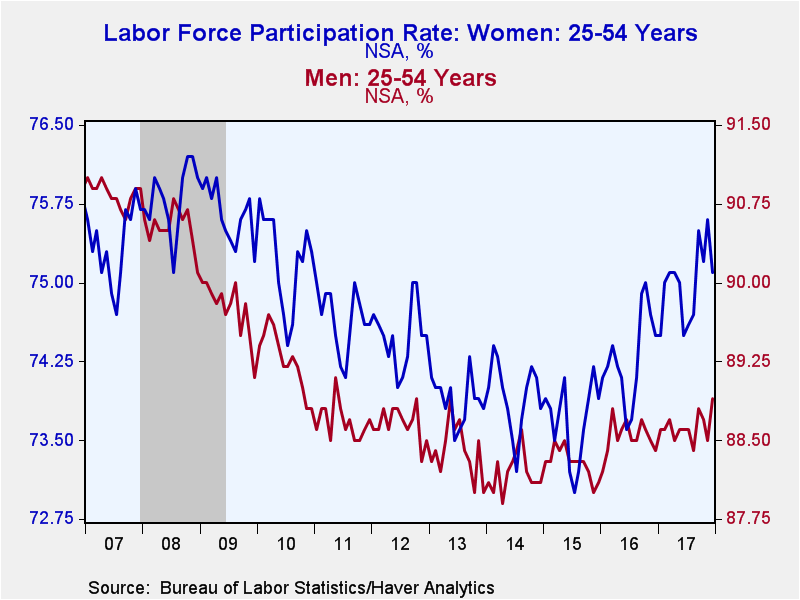 Global| Jan 05 2018
Global| Jan 05 2018U.S. Payroll Increase Disappoints; Earnings Gain Picks Up & Jobless Rate Holds Steady
by:Tom Moeller
|in:Economy in Brief
Summary
The labor market exhibited tepid growth last month. Nonfarm payrolls increased 148,000 (1.5% y/y) during December following a 252,000 November rise and a 211,000 October gain. Together these two figures were revised down by 9,000. A [...]
The labor market exhibited tepid growth last month. Nonfarm payrolls increased 148,000 (1.5% y/y) during December following a 252,000 November rise and a 211,000 October gain. Together these two figures were revised down by 9,000. A 190,000 increase in payrolls had been expected in the Action Economics Forecast Survey. The unemployment rate held steady at an expected 4.1%. The overall unemployment rate, including the marginally-attached and those working part-time for economic reasons, ticked higher to 8.1% from 8.0%, down from 9.1% one year earlier. Average hourly earnings increased an expected 0.3% (2.5% y/y) after rising an unrevised 0.1% in November.
From the payroll employment survey, The disappointing 148,000 increase in jobs was the weakest since the hurricane-depressed 38,000 September gain. Weakness centered in the private service sector where employment in retail trade declined 20,300 (-0.2% y/y), pulled down by a 27,000 drop (-2.2% y/y) in general merchandise store jobs. In addition, the 19,000 rise (2.5% y/y) in professional & business services employment was less than half the gain in the prior two months. Professional & tech services jobs declined 4,700 (+2.3% y/y) reflecting fewer jobs in accounting and bookkeeping. Temporary help jobs rose 7,000, the weakest increase since April. Employment in education rose 28,000 (+2.0% y/y) after a 50,000 increase, but leisure & hospitality employment rose a modestly improved 29,000 (2.0% y/y). Information sector employment gained 7,000 (-1.6% y/y), the first meaningful increase since September of 2016, and financial services jobs rose a weakened 6,000 (1.6% y/y). Government sector employment edged just 2,000 higher (0.2% y/y). The number of federal government jobs rose 1,000 (-0.6% y/y). State government employment declined 4,000 (-0.3% y/y) local area employment rose 5,000 (0.6% y/y).
The length of the average workweek held m/m at 34.5 hours, but that was up from 34.3 hours early this year. Factory sector hours of 40.8 has been fairly steady since 2015. Construction sector hours jumped to 39.3, the longest workweek since April. Professional & business services hours held m/m at 36.0, but that was down from the 36.4 peak early in 2014. Financial activity hours were improved at 37.6, and in leisure & hospitality, 26.2 hours were up sharply from 26.0 twelve months ago. It was the longest workweek since early 2016. The workweek in mining & logging surged to a record 45.8 hours.
 The 0.3% gain in average hourly earnings left the 2.5%
y/y rise below its 2.9% y/y peak late in 2016. Factory sector earning
growth decelerated to 1.6% y/y from 3.5% in June of 2016, while
construction sector earnings growth has been steady at 3.0%. Financial
sector earnings growth of 3.6% y/y was up from 1.7% early last year, but
professional & business services earnings growth has been stable at
2.6% y/y. Leisure & hospitality earnings were up a lessened 3.6% y/y
while education & health services earnings growth held fairly steady
at 2.2% y/y.
The 0.3% gain in average hourly earnings left the 2.5%
y/y rise below its 2.9% y/y peak late in 2016. Factory sector earning
growth decelerated to 1.6% y/y from 3.5% in June of 2016, while
construction sector earnings growth has been steady at 3.0%. Financial
sector earnings growth of 3.6% y/y was up from 1.7% early last year, but
professional & business services earnings growth has been stable at
2.6% y/y. Leisure & hospitality earnings were up a lessened 3.6% y/y
while education & health services earnings growth held fairly steady
at 2.2% y/y.
From the household employment survey, the steady 4.1% unemployment rate reflected steady 1.2% y/y growth in employment and a lessened 0.5% y/y rise in the labor force. The average duration of unemployment declined to a recovery low of 23.6 weeks, down from a 2011 peak of 39.4 weeks.
The 62.7% labor force participation rate has been moving sideways since early 2016, but there is divergence in the detail. The participation rate for males aged 25-54 has inched up to 88.9% (NSA), but the participation rate of 75.1% for females aged 25-54 has jumped from a July 2015 low of 73.0%. Participation rates for younger men and women has been steady or declining.
By educational attainment, the unemployment rate for those with less than a high school diploma at 6.5% last year was below the 14.8% peak in 2010. For high school graduates but no college, last year's 4.6% rate compared to 10.3% in 2010. Individuals with less than a bachelors degree realized 3.7% joblessness last year compared to the 2010 high of 8.4%. Last year's 2.3% unemployment rate for those with a bachelors degree or higher was down from the 2010 high of 4.7%.
Last year's 14.1% teenage unemployment rate compared to the 25.9% peak during 2010. Individuals aged 20-24 years were 7.4% unemployed last year compared to 15.5% in 2010. Those aged 25-54 years old were 3.7% unemployed last year compared to a 2010 peak of 8.6%, and those aged 55 years or over were 3.2% jobless compared to 7.0% in 2010.
The labor market data are contained in Haver's USECON database. Detailed figures are in the EMPL and LABOR databases. The expectations figures are in the AS1REPNA database.
| Employment: (SA, M/M Change, 000s) | Dec | Nov | Oct | Dec Y/Y | 2017 | 2016 | 2015 |
|---|---|---|---|---|---|---|---|
| Payroll Employment | 148 | 252 | 211 | 1.5% | 1.5% | 1.7% | 2.1% |
| Previous Estimate | -- | 228 | 244 | -- | -- | -- | -- |
| Manufacturing | 25 | 31 | 23 | 1.5 | 0.7 | 0.1 | 1.2 |
| Construction | 30 | 27 | 15 | 2.8 | 2.8 | 3.9 | 5.0 |
| Private Service-Producing | 91 | 176 | 184 | 1.6 | 1.7 | 2.1 | 2.4 |
| Government | 2 | 13 | -11 | 0.1 | 0.4 | 0.9 | 0.7 |
| Average Weekly Hours - Private Sector | 34.5 | 34.5 | 34.4 | 34.4 | 34.4 | 34.4 | 34.5 |
| Private Sector Average Hourly Earnings (%) | 0.3 | 0.1 | -0.1 | 2.5 | 2.6 | 2.6 | 2.3 |
| Unemployment Rate (%) | 4.1 | 4.1 | 4.1 | 4.7 | 4.4 | 4.9 | 5.3 |
Tom Moeller
AuthorMore in Author Profile »Prior to joining Haver Analytics in 2000, Mr. Moeller worked as the Economist at Chancellor Capital Management from 1985 to 1999. There, he developed comprehensive economic forecasts and interpreted economic data for equity and fixed income portfolio managers. Also at Chancellor, Mr. Moeller worked as an equity analyst and was responsible for researching and rating companies in the economically sensitive automobile and housing industries for investment in Chancellor’s equity portfolio. Prior to joining Chancellor, Mr. Moeller was an Economist at Citibank from 1979 to 1984. He also analyzed pricing behavior in the metals industry for the Council on Wage and Price Stability in Washington, D.C. In 1999, Mr. Moeller received the award for most accurate forecast from the Forecasters' Club of New York. From 1990 to 1992 he was President of the New York Association for Business Economists. Mr. Moeller earned an M.B.A. in Finance from Fordham University, where he graduated in 1987. He holds a Bachelor of Arts in Economics from George Washington University.


